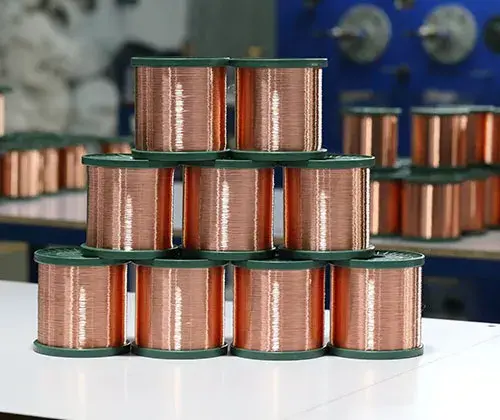
What is Magnet Wire or Enamelled wire?
Magnet Wire or Enamelled wire, also known as Winding Wire is a Copper (Cu) or Aluminium (Al) wire coated with a very thin layer of insulation. It is used in the construction of transformers, inductors, motors, generators, speakers, hard disk head actuators, electromagnets, electric guitar pickups and other applications that require tight coils of insulated wire.

Although described as “enamelled”, magnet or enamelled wire is, in fact, coated with a layer of enamel paint or vitreous enamel. Modern magnet wire typically uses one to four layers (in the case of quad-film type wire) of polymer film insulation, often of two different compositions, to provide a tough, continuous insulating layer. Magnet wire insulating films use (in order of increasing temperature range) polyvinyl formal (Formvar), polyurethane, polyamide, polyester, polyester-polyimide, polyamide-polyimide (or amide-imide), and polyimide. Polyimide insulated magnet wire is capable of operation at up to 240 °C.
Most often, magnet or enamelled wire is composed of fully annealed, electrolytically refined copper or aluminium to allow closer winding when making electromagnetic coils. High-purity oxygen-free copper grades are used for high-temperature applications in reducing atmospheres or in motors or generators cooled by hydrogen gas.
Aluminium is also used as an alternative for large transformers and motors. Because of its lower electrical conductivity, Aluminium wire requires a 1.6-times larger cross-sectional area than a copper wire to achieve comparable DC resistance.
Classifications of Magnet or Enamelled Winding Wire
Like other wire, magnet or enamelled wire is classified by diameter (AWG number, SWG or millimeters) or area (square millimeters), temperature class, and insulation class.
Size of the conductor
Measured as per AWG – American wire guage, or SWG – Standard wire guage, or in mm or inches
Thickness of Insulation
Breakdown voltage depends on the thickness of the covering, which can be of 3 types: Grade 1, Grade 2 and Grade 3. Higher grades have thicker insulation and thus higher breakdown voltages.
Type of enamel and its thermal class
The temperature class indicates the temperature of the wire at which it has a 20,000 hour service life. At lower temperatures the service life of the wire is longer (about a factor of 2 for every 10 °C lower temperature). Common temperature classes are 105 °C, 130 °C, 155 °C, 180 °C and 220 °C.
